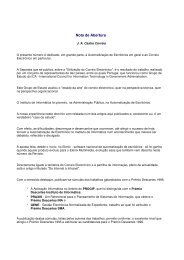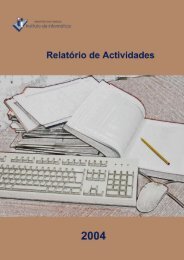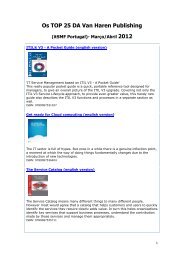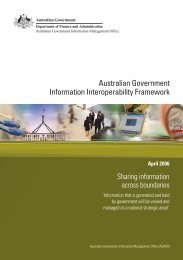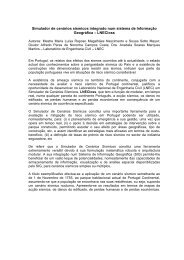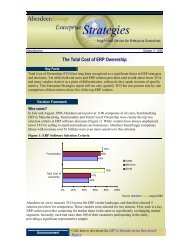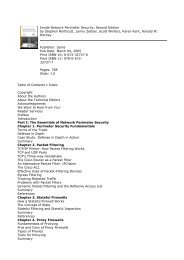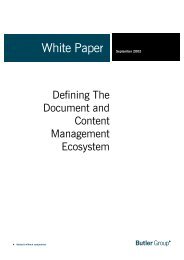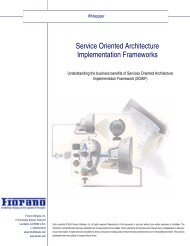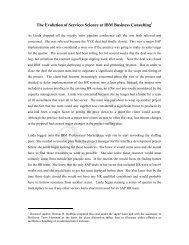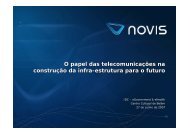OECD Peer Review of E-Government in Denmark - ePractice.eu
OECD Peer Review of E-Government in Denmark - ePractice.eu
OECD Peer Review of E-Government in Denmark - ePractice.eu
You also want an ePaper? Increase the reach of your titles
YUMPU automatically turns print PDFs into web optimized ePapers that Google loves.
- Social: society’s ability to utilize <strong>in</strong>formation technology as measured by levels <strong>of</strong> education, civil liberties, and<br />
government corruption.<br />
<strong>Denmark</strong> received high scores <strong>in</strong> a number <strong>of</strong> variables across all four pillars and placed first ahead <strong>of</strong> Sweden,<br />
the United States, Switzerland, Canada, the Netherlands, F<strong>in</strong>land, Korea, Norway, and the United K<strong>in</strong>gdom.<br />
Source: Economist Intelligence Unit “e-Read<strong>in</strong>ess Rank<strong>in</strong>g” (2005) and IDC Information Society Index (2005).<br />
ICT usage<br />
<strong>Denmark</strong> is among the top 10 ICT-us<strong>in</strong>g nations <strong>in</strong> the world, with a first-class<br />
telecommunications <strong>in</strong>frastructure. In October 2004 broadband (ADSL) network coverage reached<br />
95% <strong>of</strong> potential subscribers and by mid-2004 mobile phone penetration had reached 95.5%.<br />
Accord<strong>in</strong>g to figures from the European Commission published <strong>in</strong> February 2004, <strong>Denmark</strong> has more<br />
broadband computer connections than any other EU country, with 11.2% <strong>of</strong> the population us<strong>in</strong>g a<br />
broadband subscription by the end <strong>of</strong> 2003.<br />
Figure 3.4 Penetration <strong>of</strong> fast access connections, October 2003<br />
Source: Statistics <strong>Denmark</strong> (2004e), Key Figures on Information Society <strong>Denmark</strong> 2004.<br />
Danes have rapidly adopted ICT, as <strong>in</strong>dicated by high Internet and PC penetration rates. In 2004<br />
80% <strong>of</strong> the Danish population had a PC at home and 75% had Internet access at home (<strong>of</strong> which 99%<br />
connected via a PC, 18% via a mobile phone and 4% via a handheld computer). There was no access<br />
via digital television. In terms <strong>of</strong> the type <strong>of</strong> Internet connection used, 33% connected via a dial-up<br />
modem, 48% via broadband (XDSL and other forms), 8% via ISDN, and 22% used other forms <strong>of</strong><br />
connection <strong>in</strong>clud<strong>in</strong>g cable modems, broadband connections via build<strong>in</strong>g networks and wireless<br />
connections (see charts <strong>in</strong> the Annex to this chapter).<br />
Use <strong>of</strong> ICT by Danish bus<strong>in</strong>esses is also high. In 2004, 98% used PCs, 97% had Internet access<br />
(with 68% us<strong>in</strong>g ADSL and 8% us<strong>in</strong>g wireless connections), 81% had their own Web sites, and 57%<br />
sent and 27% received orders via the Internet. Many bus<strong>in</strong>esses, and a large number <strong>of</strong> <strong>in</strong>dividuals,<br />
used the Internet to communicate with public authorities. In 2003, 43% <strong>of</strong> <strong>in</strong>dividuals and 84% <strong>of</strong><br />
bus<strong>in</strong>esses with access to the Internet used it to f<strong>in</strong>d <strong>in</strong>formation, download forms and submit<br />
<strong>in</strong>formation to government organisations through government Web sites. Among both the public and<br />
bus<strong>in</strong>esses the highest use <strong>of</strong> e-government was for search<strong>in</strong>g for <strong>in</strong>formation – the least sophisticated<br />
opportunity provided by e-government.<br />
53



